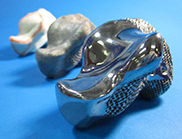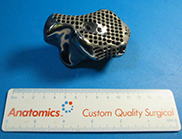CSIRO produces 3D heel in world first surgery
Printed using CSIRO’s state-of-the-art Arcam 3D printer, the heel bone was implanted into 71-year-old Len Chandler, a builder from Rutherglen Victoria, who was facing amputation of the leg below the knee following a diagnosis of cancer of the calcaneus, or heel bone.
St Vincent’s Hospital surgeon Professor Peter Choong was aware of CSIRO’s work in titanium 3D after reading about our work producing an orthotic horseshoe in 2013, and contacted CSIRO’s John Barnes in early June about his vision for a metallic implant which would support the body’s weight.
At the time, CSIRO happened to be working with the Victorian-based biotech company Anatomics on metallic implant technology and CSIRO brought Anatomics into the discussion with Professor Choong to draw on their experience as a certified custom medical device manufacturer.
At some point in the future we expect that local for-profit businesses will have the capacity to work on projects like this, and meanwhile the CSIRO is here to help local industry grow and build momentum.”
John Barnes, Director – CSIRO High Performance Metal Industries
Working from Anatomics’ schematics for the calcaneus heel bone, teams at Anatomics and CSIRO developed the design requirements with Professor Choong’s surgical team. Included in the design were smooth surfaces where the bone contacts other bone, holes for suture locations and rough surfaces to allow tissue adhesion. Anatomics and CSIRO produced three implant prototypes in the days before the surgery.
In the space of two weeks, from first phone call to surgery, CSIRO and Anatomics were able to custom-design and present an implant part to the St Vincent’s surgical team, in time for the surgery on the second week of July.
Mr Chandler returned to St Vincent’s Hospital this week for a check-up and said he was recovering well, and able to place some weight on his implant.
“The customisation of 3D printing is good in emergency situations such as these,” a member of CSIRO’s titanium printing team Dr Robert Wilson said.
“Custom designed implants mean job opportunities in this area as these types of surgeries become more commonplace.”
CSIRO is working with a number of major companies and SMEs across Australia to build capacity in biotech and manufacturing.
“3D printing is a local manufacturing process, meaning Australian companies produce implants for our own patients for our own doctors to use. We would no longer have to rely on imported parts that slow the process down and is less personal for the patient,” CSIRO’s Director of High Performance Metal Industries John Barnes said.
“At some point in the future we expect that local for-profit businesses will have the capacity to work on projects like this, and meanwhile the CSIRO is here to help local industry grow and build momentum.”
Learn about the work of our Lab 22 Additive Manufacturing group.
Media resources
Click image for high resolution version


